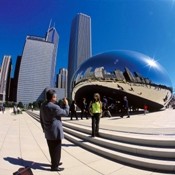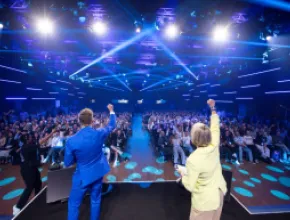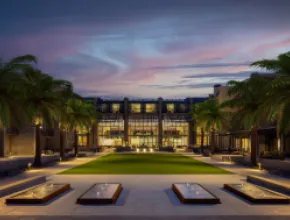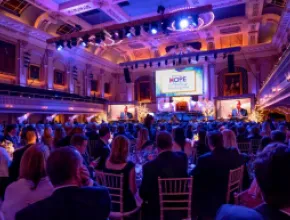A century ago, silver screen chanteuse Sarah Bernhardt declared her adoration of Chicago, calling it “the pulse of America.” Fast- forward the clock and in some ways not much has changed. The buildings are taller, the pace of life is quicker, and five cents no longer buys a beer, but Chicago is one of the country’s premier arts and cultural hubs, with a vibrant theater district, world-class museums, public art, and dazzling architecture.
The venerable Sears Tower and John Hancock Center allow for birds-eye views of the city, while newer constructions like architect Frank Gehry’s Pritzker Pavilion at Millennium Park add other interesting perspectives to the classic skyline.
On the green side, the new Millennium Park spans 25 acres, and the city’s long-standing fresh-air spaces include 1,200-acre Lincoln Park, Burnham Park and Grant Park (home to the renowned Art Institute of Chicago), in addition to nearly 30 beaches on the shores of Lake Michigan.
Chicago’s buzz-worthy dining scene features a who’s who of star chefs, while blues and jazz practically ooze from the streets. Serious shoppers fawn over designer boutiques and department stores along Michigan Avenue, nicknamed the “Magnificent Mile,” while sports fanatics find much to cheer, from the Bears to the Cubs to the Bulls.
Outside its downtown core, Chicago is home to hipster neighborhoods worth exploring, such as Bucktown and Wicker Park, alive with cafes, bars, bookstores, and trendy shopping. There are also ethnic areas such as Greektown and Little Saigon.
Chicago will also find out later this year whether its bid for the 2016 Olympics will pass to the next stage.
But not everyone is in the know when it comes to Chicago’s riches.
“What we hear a lot, especially from the international market, is they only know what they see on TV and in the movies,” says Meghan Risch, director of public relations for the Chicago Convention and Tourism Bureau. “They have no idea we’re situated on a lake. No idea how green we are and surrounded by parks, how clean the mayor keeps the city. And it’s safe. The first thing they think about is Al Capone, bang-bang. They get here and can’t believe our varied shopping, our dining.”
As part of the bureau’s attempt to promote Chicago’s allure, it recently rebranded with a refreshed logo and a planned upgrade of its website with richer content, more vivid photography and an enhanced video library. According to Risch, the site will soon offer five to seven language options to accommodate a growing influx of foreign attendees. The new tagline is “Make no little plans. Choose Chicago,” a take on a quote from architect and city planner Daniel Burnham, one of the city’s first visionaries. Burnham published the 1909 Plan of Chicago, one of the most noted documents in the history of city planning.
A number of big plans have come to fruition in the past year, with the expansion of McCormick Place convention center leading the headlines. Its $882 million McCormick Place West building added 470,000 square feet of exhibit space to the existing 2.2 million square feet, as well as an additional 250,000 square feet of meeting space, including 61 meeting rooms and a ballroom the size of a football field. The new facility allows Chicago to attract more associations and corporate groups.
Since the new McCormick Place West building opened in early August, there have been nearly 90 booked events for future years, according to Risch.
“We’re seeing associations, especially medical meetings,” she says. “That’s exactly what the building was built for—more meetings-intensive programs.”
Chicago is becoming a medical meetings headquarters mainly because of the number of teaching hospitals within the city’s proximity.
The city’s annual customers are also growing in attendee and exhibitor space, Risch notes, sparking the need for a greater number of hotel room blocks.
“There is room for growth and hotel activity. We’re seeing a lot of major hotels expanding or doing considerable renovations,” Risch says, adding that many new hotels are coming on-line, including some mid-level service hotels.
Overall, Chicago’s current downtown hotel inventory of more than 30,000 rooms is poised for an aggressive growth spurt over the next two years. An estimated 4,500 new hotel rooms are scheduled for completion by the end of 2010. By comparison, Chicago’s hotel inventory grew by approximately 5,000 rooms over the last 10 years.
On the high end, the 286-room Trump International Hotel and Tower opened in January with 20,000 square feet of meeting space.
Closer to 2009 or 2010, there will be more premier-level hotels such as a Canyon Ranch property, a JW Marriott, a Mandarin Oriental, and a Mondrian, among other brands.
Other upcoming hotels include a La Quinta Inn and Suites, scheduled to open downtown in 2009, and a Residence Inn and Staybridge Suites, both planned for next year. The boutique-style Elysian Hotel is also opening in October with 188 guest rooms and 51 private residences.
The list of current meetings-friendly hotels is extensive. On the north end of town, properties include the Westin Michigan Avenue Chicago, the Millennium Knickerbocker, the Chicago Marriott Downtown, the Sheraton Chicago Hotel and Towers, the Four Seasons Hotel Chicago, the InterContinental Chicago, and The Allerton Hotel.
South of the Chicago River are the Hyatt Regency Chicago, the Fairmont Chicago, the Renaissance Chicago, the Palmer House Hilton, and the Hotel Allegro, while closer to McCormick Place are the Congress Plaza, the Hilton Chicago and the Hyatt Regency McCormick Place.
Other meetings options beyond hotels include the University Center downtown, with function rooms that range from 435 square feet to 1,440 square feet, and the Gleacher Center at the University of Chicago, offering meeting space and Wolfgang Puck-catered events.
Aside from the crop of new hotels, there is a plan for development along the Chicago River in the busy hotel zone around Michigan Avenue. Chicago Mayor Richard M. Daley plans to create a river walk with dining and shopping venues that will span roughly one mile.
“The river has been underutilized forever,” Risch says.
The riverfront is just one of Daley’s projects. Much of his recent work has been focused on the city going green. He recently appointed a chief environmental officer to his cabinet to oversee citywide environmental efforts, and the team developed an Environmental Action Agenda, a comprehensive plan for protecting the environment and improving quality of life in the city.
As part of the plan, the city has pledged that in five years at least 20 percent of the electricity it uses will be from renewable sources. More than 500,000 trees were planted since Daley took office in 1989 and his push for rooftop gardens has evolved, with 2.5 million square feet of the city’s roof-scape now alive, including the roof of the new McCormick Place West building. There are also about a dozen hotels seeking LEED (Leadership in Energy and Environmental Design) certification. For his efforts, Daley received an award from MIT for “greening the 21st century.”
Daley has also been a proponent of growing the meetings industry in Chicago.
“We have a mayor who is passionate and supportive of meetings and conventions,” Risch says. “Our ultimate goal is to get you to come back, to have your group achieve the utmost success.”
With the buzz around what’s new, Chicago still touts its many established off-site venues and attractions.
Navy Pier features a number of venues along the waterfront, including Festival Hall, with 170,000 square feet of exhibition space, Lakeview Terrace, with space for 1,000 for dinner, and the 1916 Grand Ballroom, sporting an 80-foot dome with views of Lake Michigan. The pier’s 510-seat Shakespeare Theatre can also host groups.
Other group venue options include the Chicago Cultural Center, which presents a wide range of the performing, visual and literary arts organized by the Chicago Department of Cultural Affairs, which will be showcasing a 300-piece Marilyn Monroe exhibit this summer.
The Adler Planetarium & Astronomy Museum, which opened in 1930 as the first planetarium of the Western Hemisphere, is available for group events, as is the Art Institute of Chicago and the Museum of Science and Industry, which is celebrating its 75th anniversary this year.
Another standout off-site is Millennium Park, offering nearly 25 acres of green space and unique venue options, as well as a variety of live entertainment and programming. Groups can host private dinners on the stage at the Jay Pritzker Pavilion or work with the events department at Millennium Park for other ways to utilize the space.
On the entertainment front, groups can see performances or utilize the Second City theater, which helped catapult the careers of John Belushi, Bill Murray, Gilda Radner, Mike Meyers, and other stars.
Meanwhile, groups can arrange tours through the Chicago Architecture Foundation, focusing on architecture, neighborhoods and the arts, either on foot, bus or by boat on the river.
For More Info
Chicago Convention and Tourism Bureau 312.567.8500
www.choosechicago.com







